Bánh Chưng (Square Sticky Rice Cake)

Nguyên liệu
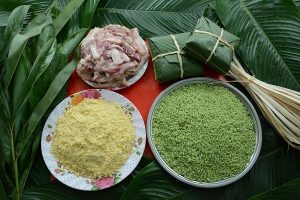
Main Ingredients
-
650g glutinous rice (soaked at least 6 hours, drained)
-
400g hulled mung beans (soaked, steamed, and mashed)
-
300g pork belly (cut into thick strips, marinated with salt and pepper)
Wrapping
-
Lá dong (dong leaves) – for traditional wrapping
-
Optional: extra banana leaves or galangal leaves (lá riềng) for aroma
Seasonings
-
Salt and ground pepper (for marinating pork and seasoning mung bean layer)
Thành phần dinh dưỡng
For: Omnivores (Vegetarian version available without pork)
Calories per serving: ~ 350–400 kcal (per 1/8 bánh ~150–180g)
Key Nutrients
1. Healthy Carbs (40–45g)
- Source: Glutinous rice + mung beans
- Benefits: Provides long-lasting energy, supports digestive health with resistant starch (especially when cooled).
2. Protein (10–12g)
- Source: Pork belly + mung beans
- Benefits: Supports muscle repair, immune health, and energy balance.
3. Healthy Fats (10–15g)
- Source: Pork belly (especially if fatty cuts used)
- Benefits: Provides energy, aids hormone production, and supports fat-soluble vitamin absorption.
4. Fiber (3–4g)
- Source: Mung beans
- Benefits: Aids digestion, supports gut health, and helps regulate blood sugar levels.
5. Essential Minerals
- Iron (mung beans + pork): Supports red blood cell production
- Zinc (pork): Boosts immunity and wound healing
- Magnesium + Potassium (beans and rice): Important for nerve and muscle function
1. Preparing the Ingredients
Before making bánh chưng, it’s essential to soak the glutinous rice. Ideally, soak the rice overnight, or at least for 4 hours.
You can soak the rice together with galangal leaves or pandan leaves to give it a green hue and pleasant fragrance.
Split mung beans (without skin) should also be soaked for 4 hours or overnight.

2. Prepping the Fillings
- Once the rice is soaked, drain it thoroughly in a colander. Sprinkle 1–2 teaspoons of salt and mix evenly by hand.
- Do the same with the mung beans: drain them, then mix with salt and pepper.
- For the pork belly, marinate with salt, pepper, and a bit of sugar.

3. Wrapping the Cakes
- To get perfect square cakes, it’s helpful to use a square mold.
- Prepare 4 dong leaves by folding the bottom edge up and the left side inward to create a crease. Repeat this for the remaining leaves. Lay the 4 folded leaves into the mold.
- Add a layer of sticky rice, making sure to press it evenly into the corners and leave a dip in the middle. Add a layer of mung beans, then place a piece of marinated pork on top, and finish with another layer of mung beans. Cover with a final layer of sticky rice.
- Try to balance the rice and mung bean layers so that both top and bottom are even.
- Wrap the cake and tie it securely with string, but not too tightly, as the rice will expand during cooking.
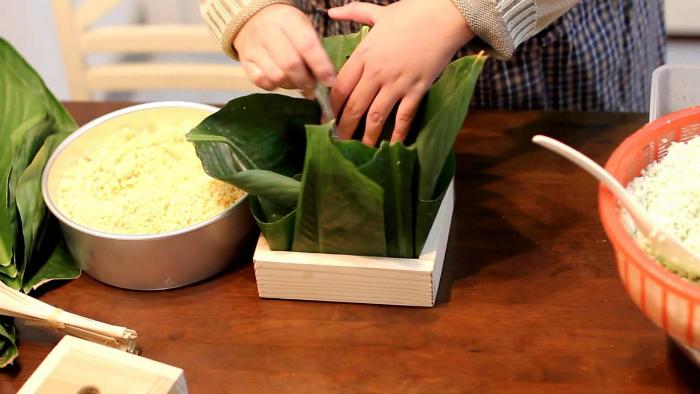
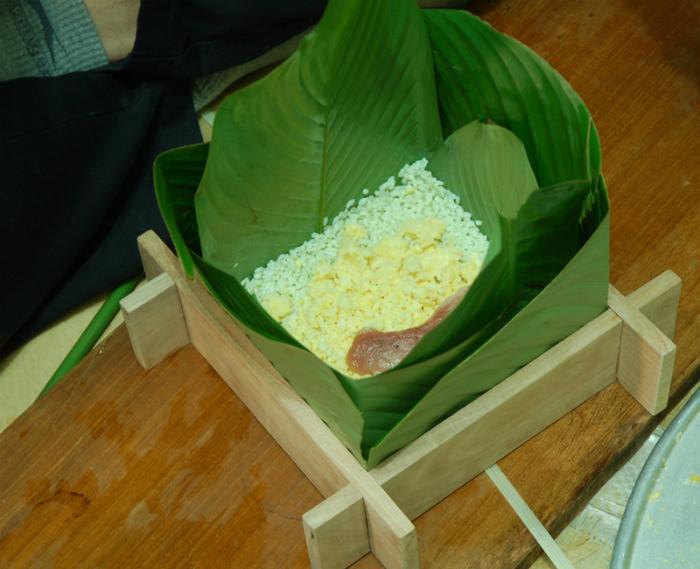
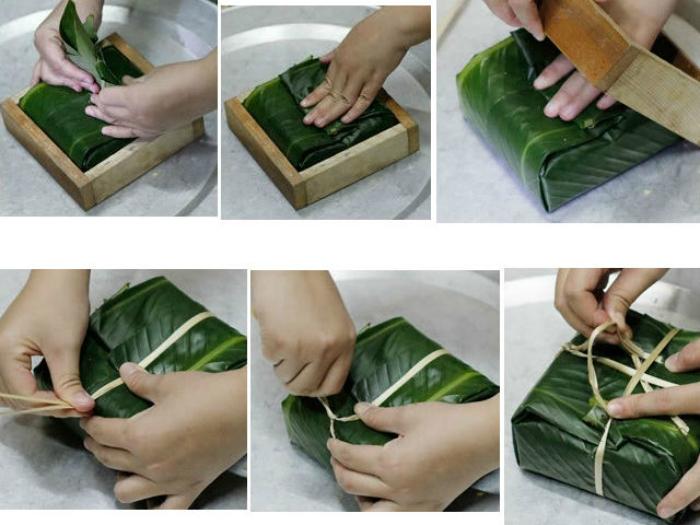
4. Boiling the Cakes
- Place the cakes in a large pot and fill it with water until the cakes are completely submerged.
- Boil for about 5 hours for small cakes; larger cakes require more time.
If using a pressure cooker, the boiling time is reduced to about 1 hour.
Prepare extra boiling water to add as needed during the cooking process.
Halfway through, flip the cakes and replace the water to ensure even cooking. - Once done, remove the cakes and immediately place them into cold water for 20 minutes.
Let them drain, then press them with a heavy object for 5–8 hours to remove excess water, prevent sogginess, and help the cakes keep longer.
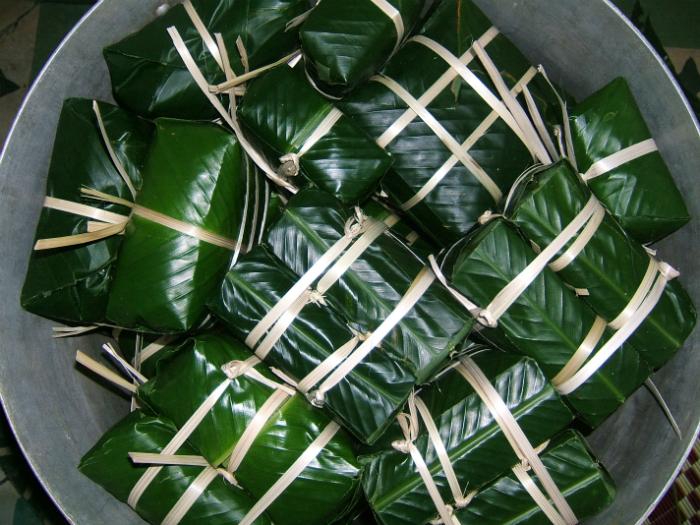
5. Final Product
Once fully cooked and pressed, bánh chưng can be stored in the refrigerator.
Whenever guests come over, just reheat the cake in the microwave before serving!
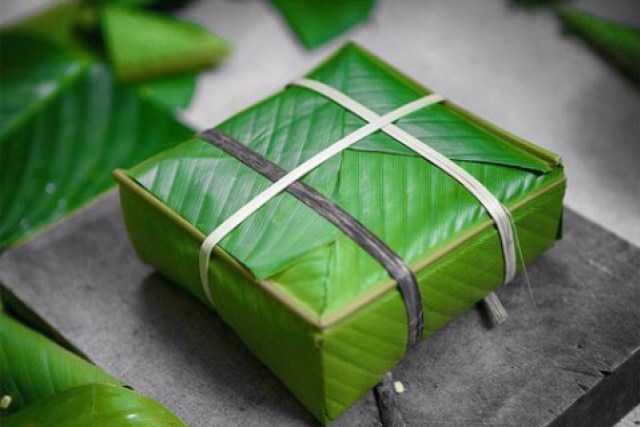
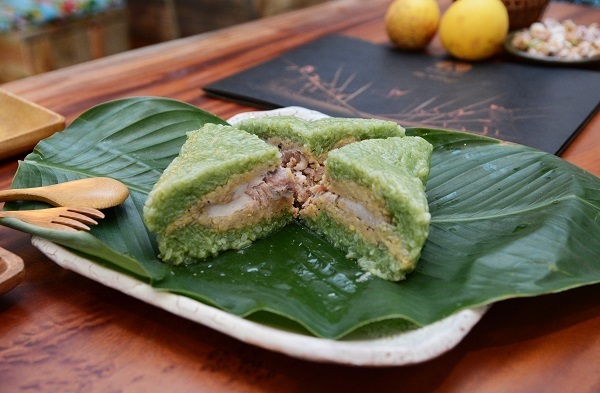
Bánh Chưng – The Vietnamese Square Sticky Rice Cake
Bánh chưng is an indispensable traditional dish during Tết, the Vietnamese Lunar New Year, and it carries deep historical, cultural, and spiritual meaning. Its origin is rooted in a famous legend about Lang Liêu, the eighteenth son of the Hùng King.

(The Tale of Lang Lieu and the Origins of Banh Chưng and Banh Giầy)
As the story goes, when the king grew old, he held a contest to choose his successor. He declared that whoever could offer him the most meaningful and delicious food would inherit the throne. While other princes searched far and wide for rare delicacies, Lang Liêu, being poor, used the most basic ingredients — glutinous rice, mung beans, and pork — to create two types of cakes: bánh chưng, a square-shaped cake representing the earth, and bánh dày, a round cake symbolizing the sky.
Impressed by Lang Liêu’s thoughtfulness and his deep respect for family and the natural world, the king crowned him as heir. Since then, bánh chưng has become a symbol of gratitude to heaven and earth, filial piety, and national unity.
Making bánh chưng is more than just preparing food — it is a cherished tradition that brings families together around the fire during the cold days of Tết. Wrapping, boiling, and sharing these cakes has become a meaningful act of remembrance, love, and cultural preservation.
(Bánh chưng – the soul of old Hanoi’s Tet holiday)